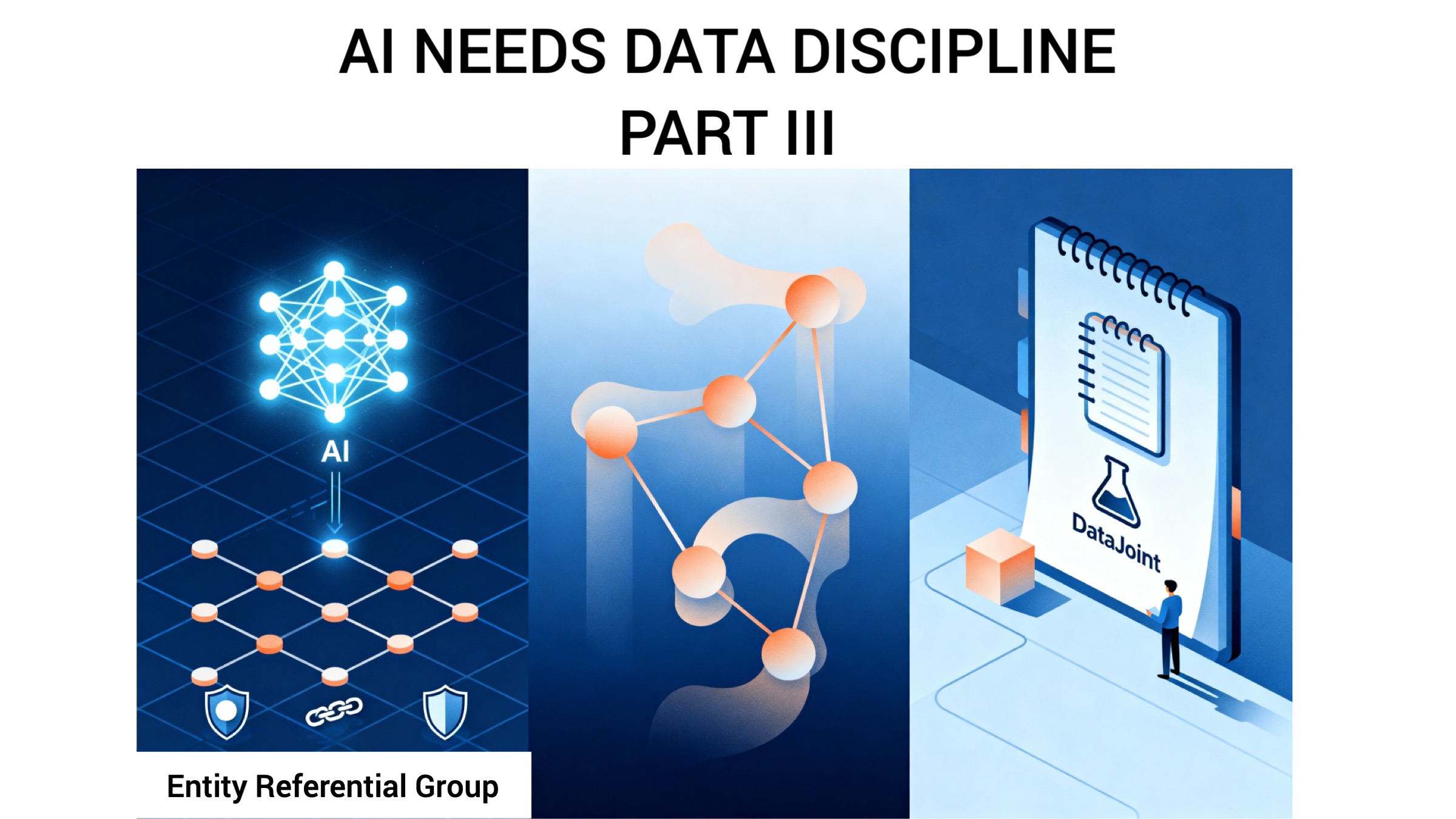You Only Need Five Query Operators

Clarity in Complexity: Why DataJoint's Five Query Operators Are All You Need
Navigating complex data demands tools that offer both power and clarity. DataJoint is designed for building and managing scientific data pipelines. The upcoming release of DataJoint Specs 2.0 marks the first time DataJoint will be developed against a formal, open specification document, embodying the philosophy of an open standard and capturing its core theoretical concepts to ensure consistent implementations across different platforms.
While many are familiar with SQL, the lingua franca of relational databases, DataJoint's query language, as defined in these new specs, employs a remarkably concise set of just five core operators. This naturally begs the question: in a world accustomed to SQL's extensive vocabulary, can just five operators truly be enough? This article argues an emphatic "yes" – not despite their small number, but precisely because of their rigorous design and unwavering commitment to fundamental relational principles.
The Theoretical Bedrock, ERM's Vision, and SQL's Journey
To appreciate DataJoint's approach, it helps to understand the foundations. Relational database theory, pioneered by Edgar F. Codd in the late 1960s/early 1970s, is built on rigorous mathematics. Codd introduced relational algebra, a procedural language where operators like selection, projection, and join manipulate tables (relations) to produce new tables. He also defined relational calculus, a declarative language allowing users to specify what data they want. Codd proved these two formalisms were equivalent in power, establishing the concept of relational completeness.
In 1976, a pivotal moment in conceptual database modeling arrived with Peter Chen's introduction of the Entity-Relationship Model (ERM). Chen proposed a way to look at the world, and thus model data, in terms of "entities" (distinguishable "things" like a student or a course) and "relationships" between them (like a student "enrolling" in a course). The ERM provided a powerful visual language—ER diagrams—that became incredibly influential for database schema design and for communication between database designers, domain experts, and stakeholders. It offered an intuitive framework for translating real-world scenarios into structured data models, naturally leading to well-normalized schemas.
However, a significant disconnect emerged. While ERM became a standard for conceptualizing and designing databases, its elegant, entity-centric syntax and explicit relationship constructs were never directly mirrored in SQL's Data Definition Language (DDL for creating tables) or its Data Query Language (DQL for retrieving data). SQL's CREATE TABLE statements, while defining columns and foreign keys (which implement ERM relationships), don't speak the direct language of "entity sets" and "relationship sets" in the way ERM diagrams do. Similarly, SQL's JOIN syntax, while powerful, doesn't inherently guide users to join tables based on the semantically defined relationships from an ERM perspective. This left a gap between the clarity of the conceptual design and the often more intricate, attribute-level syntax of SQL implementation and querying.
SQL itself emerged as a practical implementation drawing from both relational algebra and calculus. Its SELECT...FROM...WHERE structure has a declarative feel whereas JOIN is a relational algebra operator. A fascinating part of SQL's early vision was its aspiration to be a natural language interface for databases, aiming for queries that read like English prose. While admirable, this came at the cost of the explicit operator sequencing and rigorous composability found in more formal algebraic systems.
SQL’s widespread adoption, fueled by successful standardization efforts, has been immensely beneficial. However, through its evolution, SQL accumulated "conceptual baggage"—layers of complexity and ambiguity that can obscure the underlying simplicity of relational operations.
The Cornerstone: Well-Defined Query Results
A central tenet of the DataJoint philosophy, crystallized in the new Specs 2.0, is that all data, whether stored in base tables or derived through queries, must represent well-formed entity sets (or relations). What does this mean in practice? It means that every table, including any intermediate or final result of a query, must:
- Clearly represent a single, identifiable type of entity (e.g., "Students," "Experiments," "MeasurementEvents").
- Have a well-defined primary key – a set of attributes whose values uniquely identify each entity (row) within that set.
- Ensure that all its attributes properly describe the entity identified by that primary key.
This commitment is upheld through what the DataJoint Specs refer to as algebraic closure. Each of DataJoint's query operators is designed such that if you give it well-formed relations as input, it will always produce another well-formed relation as output, complete with its own clear primary key and entity type.
This brings us to a critical question to keep in mind when working with SQL: Can you always tell, just by looking at the SQL statement, what real-world entity each row in the result is meant to represent, and what makes each row unique? Often, the answer becomes murky.
DataJoint's "Fab Five": A Modern Interface to Relational Power
With deep reverence for Codd's foundational genius, it's fair to ask if the original set of algebraic operators, defined over half a century ago, still constitutes the optimal user-facing interface for today's data challenges. DataJoint, guided by its new Specs 2.0, proposes a refined, modern set of five operators designed for clarity and power:
- Restriction (
&,-): This is your precision filter. It selects a subset of rows from a table based on specified conditions without altering the table's structure or primary key. The resulting table contains the same type of entities and the same primary key. - Projection (
.proj()): This operator reshapes your view of a table by selecting specific attributes, renaming them, or computing new attributes from existing ones. Crucially, the primary key of the original table is preserved, ensuring the identity of the entities remains intact. - Join (
*): This operator combines information from two tables. But it’s not just any combination; it’s a "semantic join" (more on this later) that ensures the resulting table represents a meaningful fusion of entities, with a clearly defined primary key derived from its operands. - Aggregation (
.aggr()): This operator can be seen as an advanced form of projection. For a tableA,A.aggr(B, ...)can perform the same functions asA.proj(...)by selecting, renaming, and calculating attributes. Additionally, it can also calculate new attributes for each entity inAby summarizing related data from tableB. The beauty is that the resulting table still hasA's primary key and represents entities of typeA, now augmented with new information. Despite their similarity, we consider.projand.aggras distinct operators. - Union (
+): This operator combines rows from two tables,AandB. For this to be valid,AandBmust represent the same type of entity and share the same primary key structure; the result inherits this structure.
These five operators, through their strict adherence to producing well-defined results, form the backbone of DataJoint's expressive power.
Untangling SQL: Where Simplicity Meets a Wall of Operators (Illustrated)
Let's look at how DataJoint's approach contrasts with SQL in practice.
SQL's Operator Count – A Fuzzy Number
How many "operators" does SQL effectively have? It's notoriously hard to quantify because many distinct logical operations are bundled into the complex SELECT statement. A single SELECT can perform filtering (like DataJoint's restriction), column selection and computation (projection), table combination (join), grouping, and ordering, all intertwined.
Furthermore, seemingly simple modifiers in SQL can act like entirely new, transformative operators. Adding DISTINCT to a SELECT query doesn't just remove duplicate rows; it fundamentally changes the resulting relation, implying a new primary key based on all the selected columns. Similarly, aggregate functions like COUNT() or AVG() within a SELECT statement, with and without a GROUP BY clause, transform the output into a new type of entity (e.g., "summary per department" instead of "employees"), with the grouping columns forming the new primary key. If we were to "unroll" every distinct transformation SQL can perform, the operator count would be vastly larger and far more entangled than DataJoint's explicit five.
The SELECT Statement's Hidden Logic
The order in which SQL clauses are written (SELECT, FROM, WHERE, etc.) doesn't reflect their logical execution order. This "hidden logic" often confuses users, particularly regarding the scope of aliases defined in the SELECT list. DataJoint's explicit, sequential application of operators avoids this ambiguity entirely.
The Labyrinth of SQL Joins vs. DataJoint's Semantic Precision
SQL offers various join implementations like INNER JOIN, LEFT/RIGHT/FULL OUTER JOIN, and CROSS JOIN with various modifiers such as NATURAL, USING, and ON <condition>. Classical relational algebra also defined foundational concepts such as equijoin (joining based on equality, a specific type of a more general "theta join" which allows any comparison – though these terms are more academic than direct SQL syntax) and natural join, which have influenced SQL's join logic. However, SQL's NATURAL JOIN (matching on identically named columns) can be treacherous, as it may join attributes that share a name but have completely different meanings.
The ERM guided that meaningful joins should occur on foreign keys between related tables. DataJoint institutionalizes this with Semantic Matching for its one and only join (*) operator. For attributes to be matched, they must not only share the same name but also trace their lineage through an uninterrupted chain of foreign keys to the same original attribute definition. If identically named attributes don't meet this criterion, it's a "collision," and DataJoint raises an error, compelling the user to explicitly rename attributes using projection before the join. This rigor, tied to the foreign key relationships typically visualized in a schema diagram, means the validity of a DataJoint join is often apparent from the schema structure itself.
Semijoin and Antijoin: The Illegitimate "Joins"
Speaking of joins, relational algebra textbooks often discuss semijoin and antijoin.
- A semijoin (A⋉B) returns rows from table A for which there is at least one matching row in table B (based on common attributes), but it only includes columns from table A.
- An antijoin (A▹B) returns rows from table A for which there are no matching rows in table B, again only including columns from table A.
While these are powerful, the "join" in their names is quite a misnomer. True joins combine attributes from both participating tables to form a new, wider entity and create new entities by pairing rows from the joined tables. Semijoins and antijoins, however, don't do this. They fundamentally act as filters on table A based on the existence (or non-existence) of related records in table B. The structure of table A (its attributes and primary key) remains unchanged; you merely get a subset of its rows. This is precisely the definition of a restriction operation.
In SQL, these operators are implemented in a wide variety of ways, typically using a subquery with EXISTS, NOT EXISTS, IN, and NOT IN operators, or as an inner join followed by a GROUP BY or by using a DISTINCT modifier.
The DataJoint Specs 2.0 acknowledge the true restriction-like nature of these operators directly: when performing a restriction by a subquery (which is conceptually how one table filters another), "The restriction acts as a semijoin (for &) or an antijoin (for -)" . The earlier DataJoint manuscript (Yatsenko et al., 2018) also explicitly deprecated the terms “semijoin” and “antijoin” as misleading and confusing. DataJoint thus correctly categorizes these operations under its versatile Restriction operator, avoiding the potential confusion of SQL needing EXISTS, NOT EXISTS, IN, or NOT IN subqueries to achieve similar effects, which can feel less direct than a simple restriction.
SQL's OUTER JOINs: A Mix of Meanings
SQL's OUTER JOIN variants (like LEFT JOIN) often create results that are a jumble of entity types. Some rows might represent a complete pairing, while others represent only one entity, padded with NULLs. After such an operation, can you confidently tell what real-world entity each row in the result is meant to represent?
DataJoint's Specs 2.0 clearly state its approach: it effectively has no direct "outer join" operator because such an operation typically violates the principle of yielding a single, well-defined entity set with a consistent primary key. Instead, DataJoint's aggr operator cleanly achieves the common goal of augmenting one entity set with summaries from another, preserving the primary entity's type and identity.
Redundancy in Restriction in SQL
SQL uses multiple clauses for what amounts to filtering: WHERE, ON (in joins), HAVING (for groups), and LIMIT / OFFSET (for result sets). DataJoint streamlines this with its single, powerful Restriction operator (& and its complement -).
Illustrative Examples: DataJoint vs. SQL
Let's make these differences more concrete. (Imagine a simplified university database with Student, Course, Section, Enroll, StudentMajor, and Grade tables.)
1. Finding Students Enrolled in Any Class
- DataJoint:
Student & Enroll - Result: A well-defined set of
Studententities. - SQL:
SELECT *
FROM Student
WHERE student_id in (SELECT student_id FROM Enroll);Result: Rows from the Student table, but the logic is more verbose.
2. Counting Enrolled Students per Section
- DataJoint:
Section.aggr(Enroll, n_students='COUNT(*)')Result: Section entities, augmented with n_students.
- SQL:
SELECT sec.*, COUNT(e.student_id) AS n_students
FROM Section AS sec
LEFT JOIN Enroll AS e USING (course_id, section_id)
GROUP BY course_id, section_idResult: Requires explicit join and grouping by all parts of Section's primary key.
The DataJoint Advantage: Why These Five Excel
DataJoint's design philosophy demonstrates that true power doesn't come from a multitude of overlapping commands, but from a concise set of orthogonal, well-defined operators that compose reliably.
- Consistently Well-Defined Results (Algebraic Closure): Every operation yields a predictable, valid table with a defined primary key and entity type.
- Semantic Precision: Binary operations like
joinare based on meaningful relational links, not just coincidental name matches. - Composability: Simple, reliable steps can be combined to build sophisticated queries.
- Interpretability: The nature of the data remains clear at every stage of the query.
- Entity-Oriented Focus: The operators encourage thinking in terms of whole entities and their relationships, aligning well with conceptual modeling principles championed by the ERM as opposed to the attribute-oriented focus of SQL.
Conclusion: A Clearer Lens for Data Discovery
SQL's position as a foundational data language is secure, and its contributions are undeniable. However, for the complex, high-stakes data work found in scientific research and other demanding domains, a query interface that prioritizes conceptual clarity, predictability, and semantic integrity can be transformative.
DataJoint, as guided by its new Specs 2.0, isn't about minimalism for its own sake. It's about providing a complete and conceptually sound set of query operators that empower users. By ensuring every operation results in a well-defined entity set and by enforcing semantic integrity in operations like joins, DataJoint aims to strip away ambiguity and allow researchers to interact with their data with greater confidence and insight. It’s a compelling case that sometimes, to see further, we need not more tools, but clearer lenses.
Related posts
Neuropixels, Plainly Explained
AI and the Evolution of Relational Schemas
Insight Entrepreneurship – A New Vision for Science
Updates Delivered *Straight to Your Inbox*
Join the mailing list for industry insights, company news, and product updates delivered monthly.

.svg)





